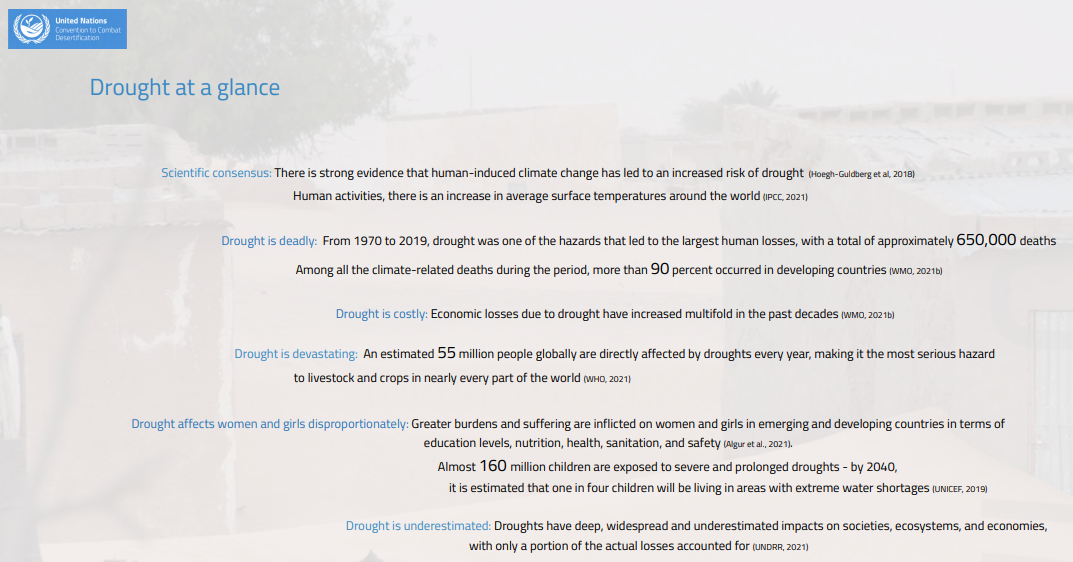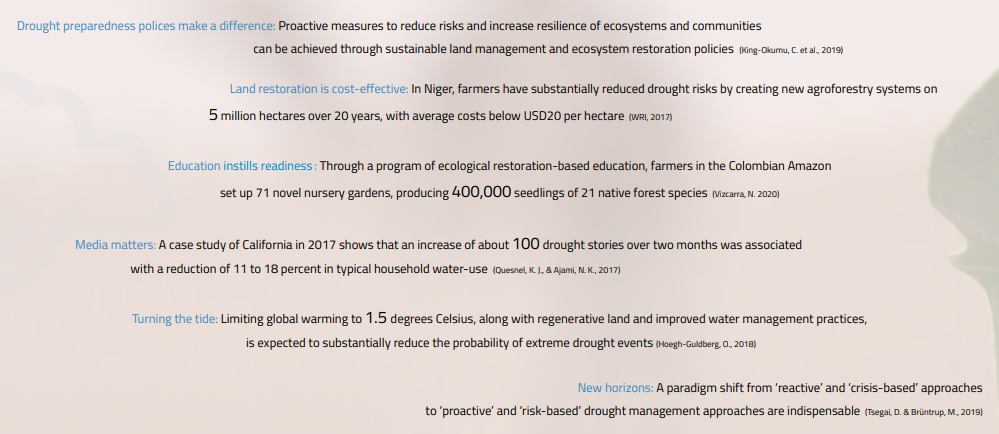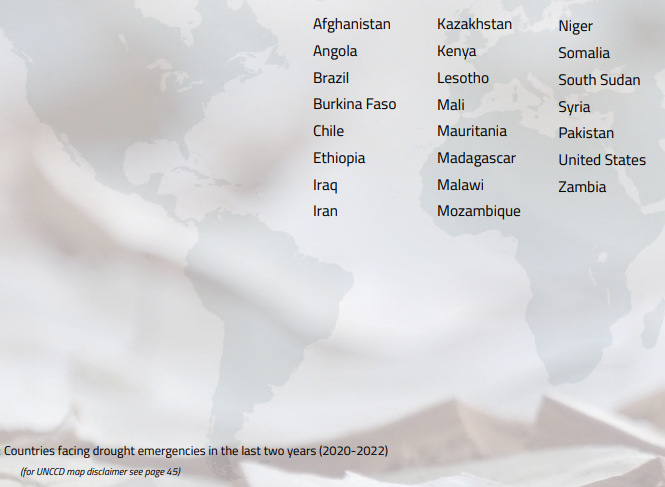1. All together against drought
Let’s start with the fact that climate change leads to more extreme weather conditions causing floods and droughts.
Probably you too asked yourself why again a post/report/book on drought. This is what we also asked ourselves initially, but soon we had the answer when seeing that there are still people, and worst of all some of the politicians, who do not believe in climate change.
The definition of drought is associated with the deficiency or absence of precipitation and/or groundwater circulation systems as compared to the typical situation. According to the World Meteorological Organization (WMO), “an area is affected by drought when the annual precipitation is lower than 60% of the normal values, at least for two consecutive years in more than 50% of its area”. Although it is true that annual precipitation is the main trigger of drought, its effects vary depending on the drought type. For more information see the Problem definition.
In Faux-Cap, Madagascar, the dunes and their strong winds pose a threat to their crops. With the greenest weapons, its inhabitants worked for 120 days to secure 75 hectares of dunes. Once settled, the risk is over.
| PHOTO: UNDP Madagascar
Rising up together from drought
| From UN CCD
Droughts are among the greatest threats to sustainable development, especially in developing countries, but increasingly so in developed nations too. In fact, forecasts estimate that by 2050 droughts may affect over three-quarters of the world’s population.
The number and duration of droughts have increased by 29 percent since 2000, as compared to the two previous decades (WMO 2021). When more than 2.3 billion people already face water stress, this is a huge problem. More and more of us will be living in areas with extreme water shortages, including an estimated one in four children by 2040 (UNICEF). No country is immune to drought (UN-Water 2021).
This year, the theme of the International Day Against Desertification, and Drought "Rising up from drought together", emphasises the need for early action to avoid disastrous consequences for humanity and the planetary ecosystems.
Droughts are increasing in frequency and severity up 29 percent since 2000 and affecting an estimated 55 million people every year, according to the latest Drought in Numbers report from UNCCD. By 2050, drylands may cover between 50 to 60 percent of all land, with an estimated three-quarter of the world’s population living in these areas under conditions of severe water scarcity.
The Horn of Africa, for example, is in its fourth year of drought. A similar drought in Southern Africa five years ago put 20 million people on the verge of starvation. This year Chile marked a record-breaking 13th year of drought. A prolonged drought in the United States that started in 2000 is the country’s driest period in over 1200 years.
In the lead-up to the 2022 Desertification and Drought Day, UNCCD launched Droughtland, a public awareness campaign featuring a fictional drought-stricken nation, to showcase solutions and rally global action to boost drought resilience.
Visit News about Drought around the World & News about Drought in NL to learn more about droughts around the world and the Netherlands.
Detailed information, which includes the programme, media resources and background documents to facilitate coverage of the event, is provided below.
Experiences
the role of science based on the drought risks identified for different climate change scenarios.
success stories of drought mitigation and adaptation in the Netherlands and other countries.
viable drought policies and their components.
Background
Drought in Numbers, released on 11 May at the fifteenth session of the Conference of the Parties to the United Nations Convention to Combat Desertification (UNCCD COP15) calls for making a full global commitment to drought preparedness and resilience in all global regions a top priority.
The report was issued just days before The State of the Global Climate 2021 report was released in May 2022 by the World Meteorological Organization (WMO). According to the report, the past seven years have been the warmest seven years on record, and drought-affected many parts of the world, including the Horn of Africa, Canada, the western United States, Iran, Afghanistan, Pakistan and Türkiye.
Drought resilience was a top agenda item at UNCCD COP15.
Countries agreed to boost drought resilience and identified some of the key actions. They will identify the areas that could turn into drylands, improve national policies, including early warning, monitoring and assessment, learn and share knowledge, build partnerships and coordinate action, and mobilize drought finance. In addition, they will set up an Intergovernmental Working Group on Drought for 2022-2024 to look into possible options, including global policy instruments and regional policy frameworks, to support a shift from reactive to proactive drought management.
The Working Group reports released earlier this year by the Intergovernmental Panel on Climate Change (IPCC) as part of the Sixth Assessment Report warn that we have up to 2030 to take actions to get us on track to staying within a temperature rise of no more than 1.5 degrees Celsius. Warming above that level would have catastrophic impacts on both people and the planet.
Drought at a glance



Drought around the world (1900-2022)
https://www.unccd.int/resources/publications/drought-numbers
More than 10 million people lost their lives due to major drought events in the past century, causing several hundred billion USD in economic losses worldwide, and the numbers are rising (Guha-Sapir, D. et al., 2021).
Severe drought affects Africa more than any other continent, with more than 300 events recorded in the past 100 years, accounting for 44 percent of the global total. More recently, sub-Saharan Africa has experienced the dramatic consequences of climate disasters becoming more frequent and intense (Taylor et al., 2017; Guha-Sapir, D. et al., 2021).
In the past century, 45 major drought events occurred in Europe, affecting millions of people and resulting in more than USD 27.8 billion in economic losses. Today, an annual average of 15 percent of the land area and 17 percent of the population within the European Union is affected by drought (Guha-Sapir, D. et al., 2021; European Environment Agency, 2017).
In the U.S., crop failures and other economic losses due to drought have totalled several hundred billion USD over the last century – USD 249 billion alone since 1980 (NOAA-NCEI, 2021).
Over the past century, the highest total number of humans affected by drought were in Asia (Guha-Sapir, D. et al., 2021).
Iran - A real country that lived and still living under a dry spell
The idea of Droughtland, an imaginary country that lives under a dry spell. Campaign materials – cartoons, animations and videos – use a dash of humour to describe the everyday challenges of living in Droughtland and encourage people to take action, so that no country becomes a real "drought land" where citizens' lives are forever altered by water scarcity.
Visit droughtland to learn more.
According to NASA:
🔹️ "The summer of 2022 has set a record heat wave in the world."
🔹️ NASA has shown the hottest places on the planet by publishing a video, and Ahvaz in the south of Iran has been the hottest place on the planet on July 15, 2022 with a temperature of 46.5 degrees Celsius above zero.
Ahvaz in Iran became the hottest place on earth
Visit “Qanat (Kariz) culture“ to learn more about managing water in dry areas in Iran.


